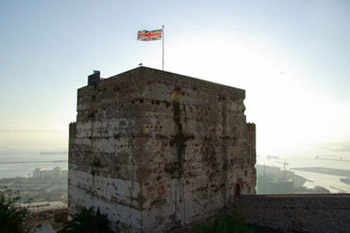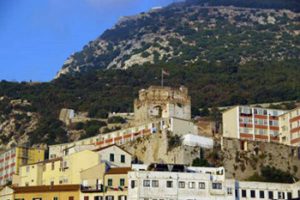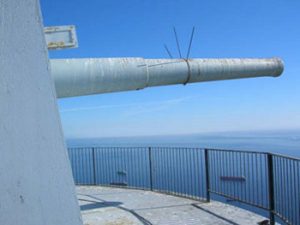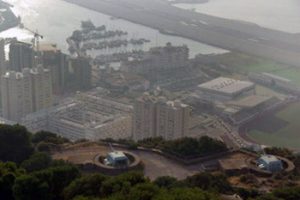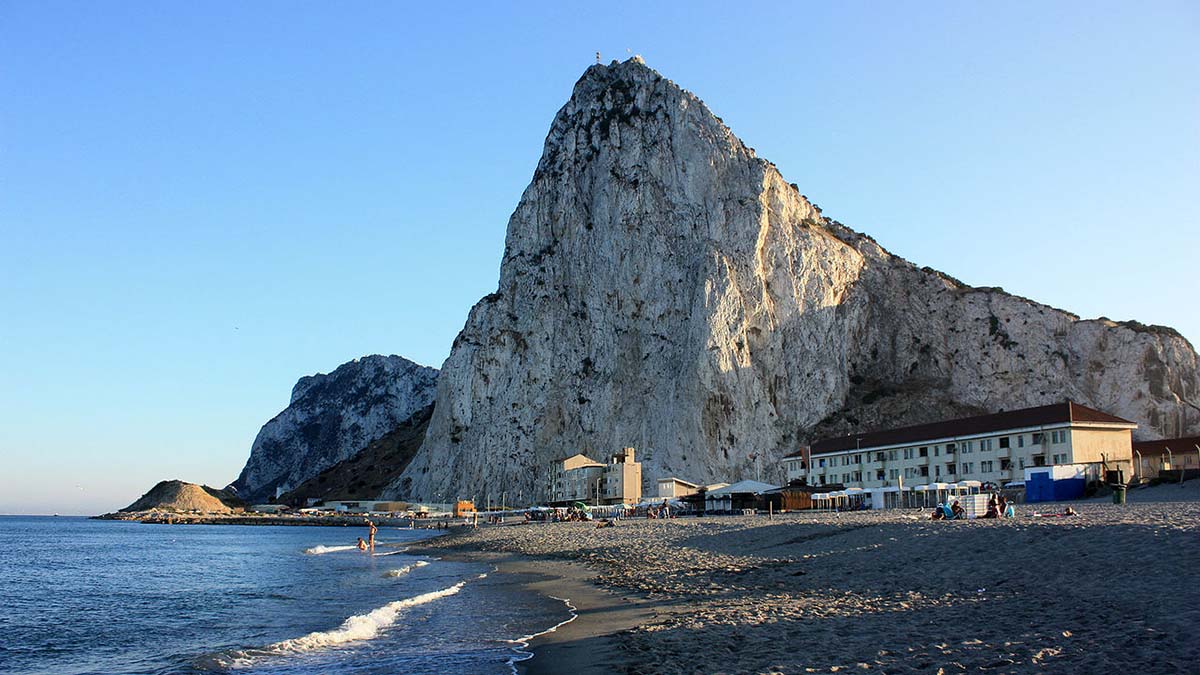
by Matthew Adams
I arrived in Gibraltar aboard the Crown Princess Grand-class cruise ship. It was returning from Corsica back to Britain. Gibraltar, a U.K. overseas territory on the south coast of Spain, was the final stop on the way back. On a sunny morning in May, I disembarked from the ship along the Western Arm in northern Gibraltar.
 Then the Rock of Gibraltar, in all its glory, came into view. The Rock rises some 426 meters above the sea. As such, it’s almost a small mountain! Even though it’s a limestone rock, the Rock of Gibraltar is very green. The Rock has lots of vegetation and an abundance of wildlife. On its higher levels there is the Upper Rock Nature Reserve, which includes various migrating birds and the famed Gibraltar Barbary macaques.
Then the Rock of Gibraltar, in all its glory, came into view. The Rock rises some 426 meters above the sea. As such, it’s almost a small mountain! Even though it’s a limestone rock, the Rock of Gibraltar is very green. The Rock has lots of vegetation and an abundance of wildlife. On its higher levels there is the Upper Rock Nature Reserve, which includes various migrating birds and the famed Gibraltar Barbary macaques.
After disembarking from the ship, I strolled through a cruise terminal building en route to the North Mole. Within the terminal building there was a sculpture of the magnificent rock. Thereafter, I arrived at the North Mole where a line of taxi vans had parked. As the taxis were providing short tours I boarded one as an alternative to climbing the Rock via the cable cars which link to the Signal Hill near its summit. They rise some 387 meters to the Water Catchment Area which provides various vantage points from the Rock.
Soon after getting in the taxi, it began the ascent up the Rock after passing through Gibraltar. The taxi van clambered up the somewhat narrow Rock of Gibraltar lanes. It stopped at the Pillar of Hercules. That’s a monument that flanks the Strait of Gibraltar which is the gateway to the Mediterranean.
St. Michael’s Cave
After a brief stop the taxi continued the climb up the Rock of Gibraltar. The next stop was St Michael’s Cave. These are a network of limestone caves located in the Upper Rock Nature Reserve.
 When the taxi stopped, I was some 300 meters above sea level. Upon vacating the taxi, a few of the Rock’s Barbary macaques surrounded the entrance to the cave. Gibraltar is the only destination in Europe where you will find any Barbary macaques.
When the taxi stopped, I was some 300 meters above sea level. Upon vacating the taxi, a few of the Rock’s Barbary macaques surrounded the entrance to the cave. Gibraltar is the only destination in Europe where you will find any Barbary macaques.
I went inside St Michael’s Cave. It’s a very finely preserved, and colourfully lit, cave with plenty of stalactites hanging from the ceiling. After entering I strolled down to the cave’s auditorium stage. With a number of plastic chairs at the higher level of the chamber this cave has been a venue for various concerts.
After leaving the cave, I returned to the taxi. We continued up the Rock and stopped somewhere close to the summit. I was probably some 350 – 400 meters up. When close to the summit of the Rock the coast of Africa is visible on a clear day.
The Great Siege Tunnels
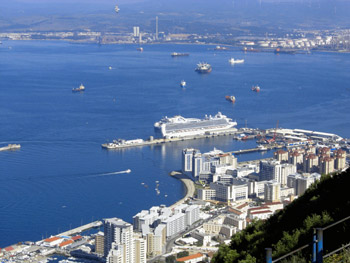 The tour continued towards the northern side of the Rock. It was there that we reached the Great Siege Tunnels which I briefly walked through. Their entrances are located at a point of the rock that overlooks Gibraltar’s airstrip close to the border.
The tour continued towards the northern side of the Rock. It was there that we reached the Great Siege Tunnels which I briefly walked through. Their entrances are located at a point of the rock that overlooks Gibraltar’s airstrip close to the border.
Given Gibraltar’s position as the gateway to the Mediterranean it was a notable strategic outpost of the British Empire, and today a Royal Navy base is still located there. As such, the British dug a network of military tunnels through the Rock during the Great Siege of Gibraltar to ensure that it remained a part of their empire. The tunnels provided cover for Gibraltar’s defenders from both naval and air bombardments. The Spanish and French never did take it, and today you can go inside the tunnels which include small windows and artillery pieces.
Grand Casemates Square
The tunnels were the last stopping point of the tour before the taxi left the Rock. We bypassed the Moorish Castle located along the north-west of the Rock. The taxi returned to Grand Casemates Square, the largest of two main squares within the city centre of Gibraltar. This square is at the northern end of Gibraltar’s Main Street. At the northern end of the square there is a bomb-proof barracks.
Here you may as well be back in England. Gibraltar is, after all, U.K. territory. Consequently, there is no requirement for Euros; and all of Gibraltar is in English! Pubs align the square which is a gateway to Gibraltar’s town centre. Further down the Main Street you can find NatWest and Barclay branches, and at the end you can board the cable cars located beside La Alameda Gardens. Those are six hectare botanical gardens.
When at the square I stopped off at the Gibraltar Glass Museum. It is here that a variety of glass is crafted by glass blowing. In the museum glass blowers craft the glass for visitors. There are also plenty of glass Rock of Gibraltars included at the museum.

 Gibraltar Beaches
Gibraltar Beaches
Although I never found them, Gibraltar also has a few beaches along its coastline. Not far off the North Front Airfield there is the Eastern Beach. Further south there are the sandy Governor’s Beach and Windhill Beach. In total there are six beaches along its eastern coastline, of which the Eastern Beach is the longest.
After a stroll down the Main Street, I returned to the ferry terminal to board the ship. The climb up the Rock of Gibraltar had provided some dazzling views of the Bay of Gibraltar and beyond. If visiting Spain this is one destination not to miss.
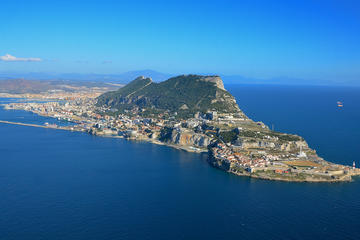
Full-day Gibraltar Tour from Seville with Rock of Gibraltar, St. Michael´s Cave
If You Go:
♦ Gibraltar Beaches
♦ Visit Gibraltar
♦ Info Centre
♦ La Alameda Gardens
♦ St Michael’s Cave
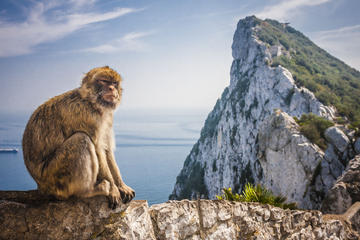
Gibraltar and Vejer Private Day Trip from Málaga
Photo credits:
Top Gibraltar Eastern Beach by Gibmetal77 / CC BY-SA
All other photos by Matthew Adams:
The summit of the Rock of Gibraltar
A Barbary macaque
The Crown Prince cruise ship
About the author:
Matthew Adams is a freelancer that has produced a variety of articles for various publications and websites such as Swing Golf Magazine,TripAdvisor, Captured Snapshot, Coed Magazine the Washington Post and Vagabundo Travel. Matthew also has his own golf blog at: amateurgolfer.blogspot.co.uk/.

